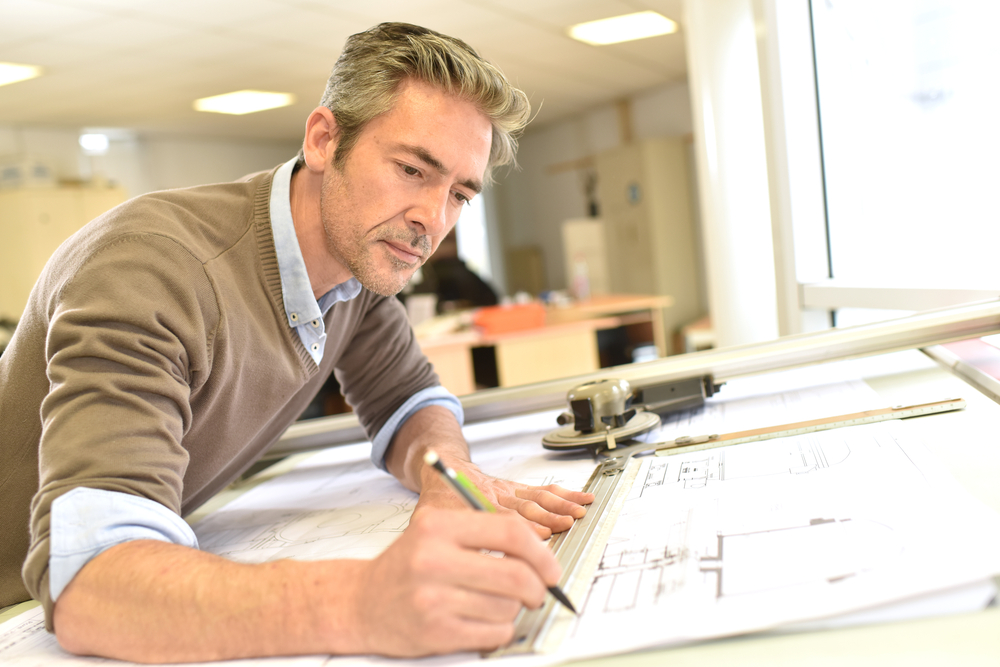Architect Tips for Creating Modern Residential Spaces
Architect Tips for Creating Modern Residential Spaces
Blog Article
Understanding the Diverse Job Paths Available for Aspiring Architect
As a hopeful Architect, you have a world of profession courses waiting for you. Each course offers one-of-a-kind obstacles and chances to apply your creativity and technical know-how. Whether you're drawn to typical architecture or the subtleties of lasting layout, there's a specific niche that straightens with your passions. Understanding these diverse choices can form your professional journey, however which instructions will you choose to explore initially?
Traditional Design: Designing Structures and Frameworks
Conventional design concentrates on developing buildings and frameworks that mix functionality with aesthetic charm. Your designs can reflect social heritage, showcasing local practices while fulfilling modern demands.
You'll develop abilities in preparing, model-making, and website analysis, enabling you to picture and connect your concepts efficiently. Involving with customers, you'll need to understand their vision and convert it into practical designs.
Moreover, building codes and sustainability methods are important in your job, ensuring your structures are eco pleasant and secure. As you grow in your career, you'll locate opportunities in property, industrial, and even reconstruction tasks, each offering one-of-a-kind challenges. Embracing typical architecture paves the means for a fulfilling profession that pays tribute to the past while shaping the future.
Urban Preparation: Shaping Neighborhoods and Public Spaces
As an aspiring Architect, you can play a necessary function as a metropolitan coordinator, transforming just how neighborhoods communicate and work. By utilizing area involvement techniques, you'll ensure that locals have a voice fit their setting. And also, integrating lasting layout principles will certainly aid create areas that not just fulfill today's needs however additionally protect the future.
Duty of Urban Planners
While numerous could think about designers as the single dreamers behind buildings, metropolitan planners play a crucial duty fit the wider landscape of communities and public spaces. They evaluate land usage, zoning legislations, and neighborhood needs to create lasting environments that enhance lifestyle. By collaborating with numerous stakeholders, you'll aid create parks, transportation systems, and houses that advertise social communication and availability. Urban organizers also concentrate on environmental considerations, guaranteeing that developments incorporate environment-friendly areas and support biodiversity. Your knowledge in spatial style and area characteristics permits you to picture future development while preserving cultural heritage. In this crucial duty, you'll straight influence just how people experience their surroundings, making every project a possibility for positive change.
Neighborhood Engagement Approaches
Effective community engagement methods are essential for city planners to guarantee that the voices of locals are listened to and valued in the preparation procedure. To cultivate purposeful discussion, you need to prioritize open forums and workshops where community members can express their ideas and issues. By actively listening and integrating comments, you'll produce areas that show the neighborhood's requirements, eventually leading to more successful and sustainable urban environments.
Lasting Design Principles
When developing metropolitan spaces, incorporating sustainable layout concepts is critical for developing settings that prosper both ecologically and socially. You ought to start by concentrating on power effectiveness, utilizing materials that reduce waste and advertise recycling. Think about integrating green rooms, like gardens and parks, to enhance biodiversity and improve air top quality. Advertising walkability and public transport can minimize dependence on cars and trucks, promoting a healthier area.
Creating with water preservation in mind is likewise essential-- consider rain yards and permeable surfaces to handle stormwater. Entailing neighborhood participants throughout the planning process assurances that the areas you develop fulfill their requirements and urge social communication. By embracing these principles, you'll contribute to vibrant, sustainable metropolitan landscapes that benefit everybody.

Landscape Architecture: Producing Lasting Exterior Atmospheres
As you discover landscape design, you'll uncover essential design principles that create stunning and practical outdoor spaces. Sustainable techniques play an essential duty in guaranteeing these settings grow while lessening environmental influence. And also, you'll find a range of career possibilities that enable you to make a genuine distinction in exactly how people engage with nature.
Design Principles in Landscape
Recognizing design principles in landscape design is vital for creating sustainable outside environments that integrate with nature. You'll require to ponder elements like equilibrium, proportion, and scale to assure your styles feel natural and welcoming. Including indigenous plants not just enhances biodiversity yet likewise minimizes water use, making your landscape resistant. Consider the circulation of room and just how people connect with it; pathways and seating areas ought to welcome expedition and leisure. In addition, take note of seasonal modifications, creating with products that enhance the environments year-round (Architect). By focusing on sustainability and looks, you can develop exterior rooms that enrich the community and promote wellness. Accepting these principles will set a strong foundation for your occupation in landscape design.
Lasting Practices Introduction
Lasting methods in landscape design not just focus on aesthetics however likewise focus on ecological health and resource preservation. You can make rooms that promote soil health and wellness, such as practicing and utilizing organic materials permaculture concepts. Inevitably, these techniques guarantee your designs profit both individuals and the setting for years to come.
Career Opportunities Exploration
With a strong foundation in sustainable methods, landscape design uses a selection of job courses that permit you to make a meaningful effect on the atmosphere. You might work as a landscape designer, creating aesthetically pleasing and functional outside spaces, or specialize in ecological remediation, assisting to restore damaged communities. Urban coordinators typically work together with landscape designers to create green rooms in city setups, improving city livability. If you're passionate about education, take into consideration coming to be a landscape the original source style instructor, inspiring future generations. Furthermore, you may collaborate with nonprofits concentrated on environmental sustainability or participate in research to innovate brand-new techniques. Each path not only shapes attractive settings however also promotes a much healthier world for future generations.
Sustainable Layout: Concentrating on Eco-Friendly Practices
As you discover your occupation in design, embracing environmentally friendly methods can establish you apart in a competitive field. Sustainable layout concentrates on creating buildings that minimize ecological influence while boosting occupant health. By including eco-friendly products, energy-efficient systems, and sustainable structure techniques, you'll contribute to a greener future.
Start by obtaining knowledge of eco-friendly qualifications like LEED or BREEAM, which can reinforce your qualifications. Take into consideration how natural light, air flow, and thermal performance can optimize design. Work together with designers and ecological consultants to innovate options that reduce waste and conserve resources.
Do not neglect the significance of neighborhood participation-- interesting local stakeholders can inspire styles that integrate with the setting. As clients significantly focus on sustainability, your experience in environmentally friendly techniques will certainly not only draw in projects however also accomplish your interest for liable style. Welcome this crucial aspect of the profession, and watch your career flourish.
Historical Conservation: Shielding and Recovering Social Heritage
While you begin on your architectural journey, take into consideration the crucial duty of historical preservation in preserving our cultural heritage. This area concentrates on the security and repair of considerable buildings, websites, and frameworks that tell the stories of our past. By participating in historical preservation, you'll help safeguard the building heritage that shapes community identity.
As a historical preservation Architect, you'll assess historical significance and analyze the condition of structures. You'll function carefully with historians and preservationists to ensure authentic reconstruction strategies are employed. This job course allows you to mix creativity with study, enabling you to make remedies that appreciate original materials and workmanship.
Your job not only adds to sustainability by recycling existing buildings yet likewise fosters a feeling of satisfaction within communities. Welcoming this path will certainly aid you end up being a guardian of background, preserving the tales and aesthetics that enrich our lives.
Inside Architecture: Enhancing Indoor Spaces
Historical conservation and interior design both share a dedication to boosting the built atmosphere, yet they concentrate on different elements. While historical preservation highlights preserving a framework's historical and social great site worth, interior design absolutely nos in on optimizing interior rooms for functionality and appearances.
As an aspiring Architect, you'll discover that indoor style allows you to blend imagination with technical skills. You'll make areas that not just look good but likewise promote comfort and performance. This field entails understanding exactly how light, shade, and materials connect within a room, influencing mood and usability.
You'll work on various jobs, from property homes to business workplaces, making certain that each setting meets the demands of its owners. By focusing on customer experience, you can change insides right into functional and inspiring spaces, making a considerable effect on exactly how individuals connect with their environments. Accept the chance to enhance indoor settings and form the method people live and work.
Industrial Design: Merging Functionality With Appearances
Commercial layout plays an essential duty in producing products that flawlessly mix aesthetic appeals with capability, guaranteeing that what you make use of day-to-day is not only aesthetically attractive but additionally functional. As an aspiring Architect, you might involve yourself in this field, concentrating on designing every little thing from furniture to customer electronics. Your job includes recognizing individual needs, products, and manufacturing procedures, allowing you to produce innovative options that enhance daily experiences.
In industrial style, you'll frequently team up with engineers, marketers, and suppliers, guaranteeing that your layouts are not just stunning yet also practical. You'll learn to balance kind and function, prioritizing functionality without giving up style. By honing your abilities in mapping out, 3D modeling, and prototyping, you'll be well-equipped to bring your ideas to life. This job path provides a vibrant environment where imagination fulfills usefulness, making it a rewarding choice for designers thinking about forming the items of tomorrow.
Often Asked Questions
What Educational Certifications Do I Required to Become an Engineer?
To come to be a designer, you'll need a specialist degree in architecture, commonly a Bachelor's or Master's. Furthermore, you'll have to complete a teaching fellowship and pass the Architect Registration Assessment to practice legitimately.
Are There Qualification Demands for Different Building Profession Paths?
Yes, there're certification needs for different building paths. Architect. You'll require to pass examinations, complete teaching fellowships, and sometimes go after specialized training, depending on your picked focus, like landscape design, urban style, or historic preservation
What Software Skills Are Important for Engineers Today?

How Can I Gain Practical Experience While Researching Design?
You can gain sensible experience by interning at architectural companies, getting involved in layout competitions, volunteering for neighborhood projects, or teaming up with schoolmates on real-world projects. These chances boost your abilities and build beneficial connections in the market.
What Work Opportunities Exist Outside Traditional Style Firms?
You can explore different work possibilities outside standard design firms, like city preparation, indoor design, landscape style, building and construction monitoring, real estate growth, or also roles in sustainability consulting. Each deals distinct obstacles and benefits.
Whether you're drawn to typical architecture or the nuances of lasting design, there's a particular niche that straightens with your interests.When making metropolitan areas, including lasting style principles is important for creating settings that grow both environmentally and socially.As you discover landscape style, you'll find vital layout concepts that create attractive and functional exterior rooms.Recognizing layout principles in landscape style is crucial for creating lasting outdoor atmospheres that harmonize with nature.In commercial style, you'll commonly work together with online marketers, designers, and suppliers, ensuring that your designs are not only stunning but likewise possible.
Report this page